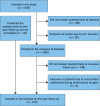Urinary dysfunction in patients with rectal cancer: a prospective cohort study
- PMID: 31334903
- PMCID: PMC6973078
- DOI: 10.1111/codi.14784
Urinary dysfunction in patients with rectal cancer: a prospective cohort study
Abstract
Aim: Urinary dysfunction is one of many complications after treatment for rectal cancer. The aim of this study was to evaluate the prevalence of patient-reported urinary dysfunction at the time of diagnosis and at 1-year follow-up and to assess the risk factors linked to urinary incontinence.
Method: Patients with newly diagnosed rectal cancer were included in the QoLiRECT study between 2012 and 2015. Questionnaires from the time of diagnosis and 1-year follow-up were analysed, with 1085 and 916 patients, respectively, eligible for analysis. Regression analyses were made to investigate possible risk factors for incontinence. The patient cohort was also compared with a cohort from the Swedish general population.
Results: At baseline, the prevalence of urinary dysfunction (14% of women, 8% of men) was similar to that in the general population. At 1-year follow-up, 20% of patients experienced urinary incontinence (29% of women, 14% of men). Emptying difficulties were experienced by 46% (41% of women, 49% of men) and urgency by 58% across both sexes. Abdominoperineal excision and urinary dysfunction at baseline were found to be independent risk factors for incontinence at 1-year follow-up. Among patients who were continent at baseline, risk factors were female sex, physical inactivity at baseline, comorbidity and abdominoperineal excision.
Conclusion: Urinary dysfunction is frequent among patients with rectal cancer, with up to a two-fold increase in symptoms 1 year after diagnosis. Unfortunately, few factors are modifiable and these results stress the importance of informing patients of possible outcomes related to urinary dysfunction after treatment for rectal cancer.
Keywords: PROM; Urinary dysfunction; rectal cancer.
© 2019 The Authors. Colorectal Disease published by John Wiley & Sons Ltd on behalf of Association of Coloproctology of Great Britain and Ireland.
Conflict of interest statement
None of the authors have any conflicts of interest.
Figures




References
-
- Kodeda K, Johansson R, Zar N et al Time trends, improvements and national auditing of rectal cancer management over an 18‐year period. Colorectal Dis 2015; 17: O168–79. - PubMed
-
- MacFarlane JK, Ryall RD, Heald RJ. Mesorectal excision for rectal cancer. Lancet 1993; 341: 457–60. - PubMed
-
- Panjari M, Bell RJ, Burney S, Bell S, McMurrick PJ, Davis SR. Sexual function, incontinence, and wellbeing in women after rectal cancer–a review of the evidence. J Sex Med 2012; 9: 2749–58. - PubMed
-
- Jones OM, Stevenson AR, Stitz RW, Lumley JW. Preservation of sexual and bladder function after laparoscopic rectal surgery. Colorectal Dis 2009; 11: 489–95. - PubMed
-
- Bregendahl S, Emmertsen KJ, Lindegaard JC, Laurberg S. Urinary and sexual dysfunction in women after resection with and without preoperative radiotherapy for rectal cancer: a population‐based cross‐sectional study. Colorectal Dis 2015; 17: 26–37. - PubMed
Publication types
MeSH terms
LinkOut - more resources
Full Text Sources
Medical

